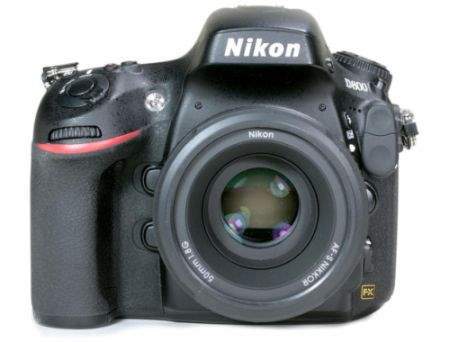WHILE Nikon’s D800 isn’t a surprise – a replacement for the company’s aging full-frame (FX) D700 was expected – the fact that it features the highest-resolution image sensor of any DSLR at this time certainly caused many eyebrows to lift.
Gone is the modest 12-megapixel image sensor of the D700 and in its place is an all-new 36.3-megapixel FX image sensor, which is even higher in resolution than Nikon’s upper-end D4’s 16-megapixel unit.
Of course, the D800 and D4 are aimed at different customers. The D4 is a fast shooter with great low-light performance while the D800 trades speed and ISO performance for amazing image-resolution.
We got our hands on the D800 and as this review will show, the camera holds its own on a number of surprising fronts.
In the hand
The D800 is one hefty beast. It’s about the same size as the D700 (which means it’s between the D7000 and D4 in size) and has completely redesigned aesthetics.
This new Nikon DSLR has more rounded edges than its predecessors, and has gained “slopey” shoulders – a design choice which I think is not as nice as the D4’s “square” shoulders.
Also, some buttons have been changed in functionality over those on the D700. For example, the “+” and “-” buttons for zooming in and out of images during playback have been reversed, in line with the D4’s layout.
This takes a bit of getting used to, since I tended to hit the zoom out button when I wanted to zoom in on an image during playback.
Thankfully, though not much else has been moved around, except for the video record button which now sits just behind the shutter release button on the top plate. It is more logically placed here for less shake when starting/stopping video recording, in my opinion.

The camera has a dual card-slot – one SD slot and another for a CompactFlash (CF) card, which is a bit of a drag since to fill both slots you will need two different kinds of storage cards.
I understand that Nikon does this to continue support for professional photographers who typically use CF but I believe Nikon should move over to the SD card completely since these are now cheaper, more common and come in large capacities.
Shooting speed for the D800 is a rather sedate four-frames-per-second (fps) thanks to the camera having to move relatively large files from the buffer to the storage card. Therefore, sports shooters may not find the D800 fast enough to capture “the moment.” But for the rest of us, shooting speed won’t be that important.

Shooting video
There are a number of interesting features that have trickled down from the earlier D4 to this D800 that’s just hitting the shelves, especially in the area of shooting video. For one thing, you now get stereo audio output, as well as an audio level meter for monitoring audio levels during video recording.
In Live View mode, you can also change apertures on the fly and see the effect immediately. Previously, on the D7000 which is an older camera to the D800, apertures were fixed at whatever aperture you had it at when you engaged Live View, which meant that should you want to change apertures, you’d have to turn off Live View, switch apertures, and then turn on Live View again. That’s finicky with a capital “F.”
Similarly, video effects can also be applied and seen immediately in Live View mode. For example, you can now turn on the monochrome effect and record black-and-white movies on the fly with the D800.
If you have an external digital video recorder, you can also take advantage of uncompressed video output via the camera’s HDMI connector.
Video recording options top out at 1080p at 30fps but if you want to shoot at 60fps, you can bring the resolution down to 720p.
 QUICK ACCESS: The D800 has familiar button array found in the company’s pro-level cameras for quality, white balance, ISO and bracketing settings.
QUICK ACCESS: The D800 has familiar button array found in the company’s pro-level cameras for quality, white balance, ISO and bracketing settings.How It performs
As expected of a camera at this level, the D800 performs well – the autofocus is speedy, and uses the same 51-point AF system as on the D4.
Even in Live View mode, the D800’s contrast-detect autofocus is a tad faster and more positive than the system on the older D7000, so Nikon seems to have improved the AF performance even in Live View mode.
Metering and white balance are noticeably better than with the D700 (and the D7000), thanks to the same 91,000-pixel metering sensor as used in the D4. I am impressed with how accurate the metering and white balance of the D800 is.
As for resolution, the D800 is impressive here too. With a good lens paired to this camera body, the D800 is capable of staggering amounts of photo detail. In our test photos, the camera captured so much detail that I was blown away by the results.
If you think that with a great megapixel count comes great noise, think again. In our tests, the D800 showed surprisingly low-noise performance, even at very high ISO settings.
While this doesn’t compare with the high ISO performance of say, the D4, the D800 certainly held its own really well.
We got perfectly usable and very low noise results from ISO100 to 1600, with ISO3200 showing a bit of noise creeping in, in the dark areas of the images.
At the top ISO setting of 6400, the D800 produced perfectly usable results, although at this point the noise-reduction algorithm kicked in a little harder.
Of course, at the ISO boost settings of 12,800 (Hi1) and 25,600 (Hi2) noise and colour shifts occured and noise reduction kicked in very hard.
If you want to check out the images we shot for our ISO tests, go to goo.gl/pQlnr.
In terms of battery life, the D800 will take a large amount of heavy shooting before this runs down. I’d say about two days of serious shooting before you have to recharge, unless you’re making videos, in which case the battery will last you a day or less before needing a recharge.
One other thing worth mentioning is that Nikon seems to be standardising on the type of battery used in its semi-pro and consumer models. The D800, D600 and D7000 all use the same 1,900mAh EN-EL15 battery, which is good because you can simply swap batteries if you own any of these Nikon DSLRs if you run out of power unexpectedly.
Final thoughts
Priced at RM10,899 for body only, the D800 is firmly in the serious amateur or professional user categories. If you fall into either of those groupings and can afford it, you’re getting a camera that offers a resolution that is currently the highest on the market.
Its high ISO performance is another plus. And it is heartening to know that technology hasn’t hit the wall when it comes to high-resolution cameras with low noise at high ISO settings.
Should you get one? If you can afford it, most definitely. But remember that to be able to take advantage of the image quality that is possible with the D800, you need to pair it with equally spectacular lenses.
By the way, the D800 has a sibling in the D800E, which has a slightly different (and less aggressive) low-pass filter that potentially produces slightly sharper and more detailed images (but at the expense of reproducing moire patterns when shooting textiles or any other stuff with repeating patterns). The D800E goes for about RM1,000 more, over the price of the D800.
Pros: Amazing detail and resolution from the 36-megapixel sensor; camera body feels like it is built tough as a tank; stereo output for audio monitoring during video recording.
Cons: Top continuous shooting speed is only 4fps (or 5fps in DX crop mode); priced at a premium.
D800
(Nikon Corp)
DSLR
SENSOR: 36.3-megapixels CMOS (7360 x 4912-pixels)
VIEWFINDER: 3.2in TFT LCD (921,000-pixels)
SHUTTER SPEED: 30sec 1/8,000sec, plus B
ISO RANGE: 100 to 6,400 (50-25,600 in ISO boost mode)
SHOOTING MODES: Program, Aperture-priority, Shutter-priority, Manual, Auto
VIDEO MODE FORMAT: MOV, H.264
BATTERY: 1900mAh EN-EL15 Lithium-ion battery
STORAGE: SDXC, CompactFlash card slots
INTERFACE: USB 3.0, HDMI, stereo audio in/out, video-out
OTHER FEATURES: Live view with face-detect autofocus
DIMENSIONS (W x H x D): 146 x 123 x 82mm
WEIGHT: 900g (with battery)
WEBSITE: www.nikon.com.my
PRICE: RM10,899 (body only)
RATING: 4.5/5stars











